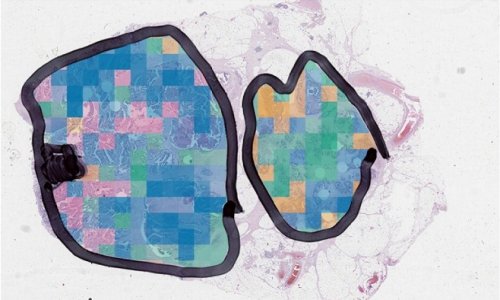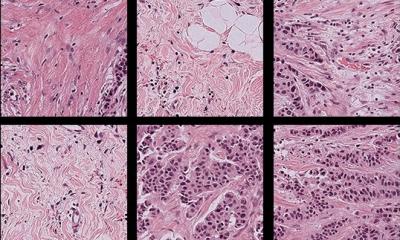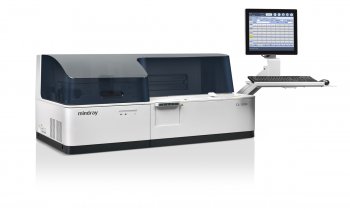Oncology
Easier Detection of Colorectal Cancer
Chemists at Caltech have developed a new sensitive technique capable of detecting colorectal cancer in tissue samples—a method that could one day be used in clinical settings for the early diagnosis of colorectal cancer.

Colorectal cancer is the third most prevalent cancer worldwide and is estimated to cause about 700,000 deaths every year. Metastasis due to late detection is one of the major causes of mortality from this disease; therefore, a sensitive and early indicator could be a critical tool for physicians and patients.
A paper describing the new detection technique currently appears online in Chemistry & Biology and will be published in the July 23 issue of the journal's print edition. Caltech graduate student Ariel Furst (PhD '15) and her adviser, Jacqueline K. Barton, the Arthur and Marian Hanisch Memorial Professor of Chemistry, are the paper's authors.
"Currently, the average biopsy size required for a colorectal biopsy is about 300 milligrams," says Furst. "With our experimental setup, we require only about 500 micrograms of tissue, which could be taken with a syringe biopsy versus a punch biopsy. So it would be much less invasive." One microgram is one thousandth of a milligram.
The researchers zeroed in on the activity of a protein called DNMT1 as a possible indicator of a cancerous transformation. DNMT1 is a methyltransferase, an enzyme responsible for DNA methylation—the addition of a methyl group to one of DNA's bases. This essential and normal process is a genetic editing technique that primarily turns genes off but that has also recently been identified as an early indicator of cancer, especially the development of tumors, if the process goes awry.
When all is working well, DNMT1 maintains the normal methylation pattern set in the embryonic stages, copying that pattern from the parent DNA strand to the daughter strand. But sometimes DNMT1 goes haywire, and methylation goes into overdrive, causing what is called hypermethylation. Hypermethylation can lead to the repression of genes that typically do beneficial things, like suppress the growth of tumors or express proteins that repair damaged DNA, and that, in turn, can lead to cancer.
Building on previous work in Barton's group, Furst and Barton devised an electrochemical platform to measure the activity of DNMT1 in crude tissue samples—those that contain all of the material from a tissue, not just DNA or RNA, for example. Fundamentally, the design of this platform is based on the concept of DNA-mediated charge transport—the idea that DNA can behave like a wire, allowing electrons to flow through it and that the conductivity of that DNA wire is extremely sensitive to mistakes in the DNA itself. Barton earned the 2010 National Medal of Science for her work establishing this field of research and has demonstrated that it can be used not only to locate DNA mutations but also to detect the presence of proteins such as DNMT1 that bind to DNA.
In the present study, Furst and Barton started with two arrays of gold electrodes—one atop the other—embedded in Teflon blocks and separated by a thin spacer that formed a well for solution. They attached strands of DNA to the lower electrodes, then added the broken-down contents of a tissue sample to the solution well. After allowing time for any DNMT1 in the tissue sample to methylate the DNA, they added a restriction enzyme that severed the DNA if no methylation had occurred—i.e., if DNMT1 was inactive. When they applied a current to the lower electrodes, the samples with DNMT1 activity passed the current clear through to the upper electrodes, where the activity could be measured.
"No methylation means cutting, which means the signal turns off," explains Furst. "If the DNMT1 is active, the signal remains on. So we call this a signal-on assay for methylation activity. But beyond on or off, it also allows us to measure the amount of activity." This assay for DNMT1 activity was first developed in Barton's group by Natalie Muren (PhD '13).
Using the new setup, the researchers measured DNMT1 activity in 10 pairs of human tissue samples, each composed of a colorectal tumor sample and an adjacent healthy tissue from the same patient. When they compared the samples within each pair, they consistently found significantly higher DNMT1 activity, hypermethylation, in the tumorous tissue. Notably, they found little correlation between the amount of DNMT1 in the samples and the presence of cancer—the correlation was with activity.
"The assay provides a reliable and sensitive measure of hypermethylation," says Barton, also the chair of the Division of Chemistry and Chemical Engineering. "It looks like hypermethylation is good indicator of tumorigenesis, so this technique could provide a useful route to early detection of cancer when hypermethylation is involved."
Looking to the future, Barton's group hopes to use the same general approach in devising assays for other DNA-binding proteins and possibly using the sensitivity of their electrochemical devices to measure protein activities in single cells. Such a platform might even open up the possibility of inexpensive, portable tests that could be used in the home to catch colorectal cancer in its earliest, most treatable stages.
Source: Caltech
15.07.2015











